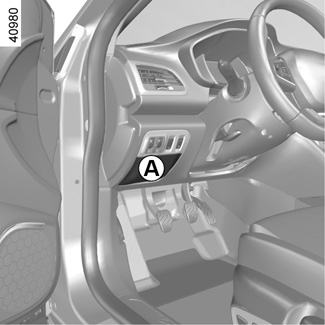FUSES

Fuse box
If any electrical component does not work, check the condition of the fuses.
Unclip the access flap A.
Use the fuse allocation label on the back of flap A to identify the fuses.
Certain fuses should only be replaced by a qualified professional. These fuses are not listed on the label.
Only change the fuses represented on the label.

Tweezers 1
Remove the fuse using tweezers 1, located at the back of flap A.
To remove the fuse from the tweezers, slide the fuse to the side.
It is not advisable to use the free fuse locations.
In accordance with local legislation or as a precautionary measure:
obtain an emergency kit containing a set of spare bulbs and fuses from an approved Dealer.
Check the fuse in question and replace it, if necessary, by a fuse of the same rating.
If a fuse is fitted where the rating is too high, it may cause the electrical circuit to overheat (risk of fire) in the event of an item of equipment using an excessive amount of current.
Allocation of fuses
(the presence of certain fuses depends on the vehicle equipment level)
Symbol | Allocation | Symbol | Allocation | ||
|---|---|---|---|---|---|
H
| Windscreen washer
| Ý
| Towbar socket
| ||
ë
| Not used |
| Not used
| ||
Æ
| Front cigarette lighter, front and rear second row accessories socket
|
| Diagnostic socket, audio alarm
| ||
| Not used | Ì
| Horn
| ||
| Heated door mirrors
|
| Instrument panel, dashboard control lighting
| ||
×
| Brake lights, passenger compartment central unit
| O | Locking opening elements, boot opening and closing control
| ||
| Parking brake
| D
| Direction indicator lights, hazard warning lights
| ||
| Additional servo |
| Rear USB sockets on console
| ||
î
| Radio, multimedia screen, multimedia accessories sockets, parking brake control
| ||||
| Passenger compartment centre unit, rear wiper, rear fog light
|